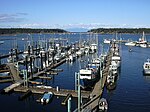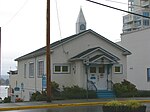Snake Island (Nanaimo)

Snake Island is a small, uninhabited, rocky island northeast of Nanaimo. It is a minor member of the large group of islands east of southern Vancouver Island called the Gulf Islands. It is a bird sanctuary, and home to a colony of harbour seals. The island is a frequent destination for local wildlife tours, and the rocky shores and reefs around the island are popular with divers. Local seals have become accustomed to divers in the water, and will interact with them. Snake Island is near the site of the artificial reef created by the sinking of HMCS Cape Breton, a Second World War Victory ship. The vessel was acquired and prepared by the Artificial Reef Society of British Columbia.
Excerpt from the Wikipedia article Snake Island (Nanaimo) (License: CC BY-SA 3.0, Authors, Images).Snake Island (Nanaimo)
Malaspina Drive, Area B (DeCourcy/Gabriola/Mudge)
Geographical coordinates (GPS) Address Nearby Places Show on map
Geographical coordinates (GPS)
| Latitude | Longitude |
|---|---|
| N 49.2152 ° | E -123.8906 ° |
Address
Malaspina Drive
V0R 1X1 Area B (DeCourcy/Gabriola/Mudge)
British Columbia, Canada
Open on Google Maps






